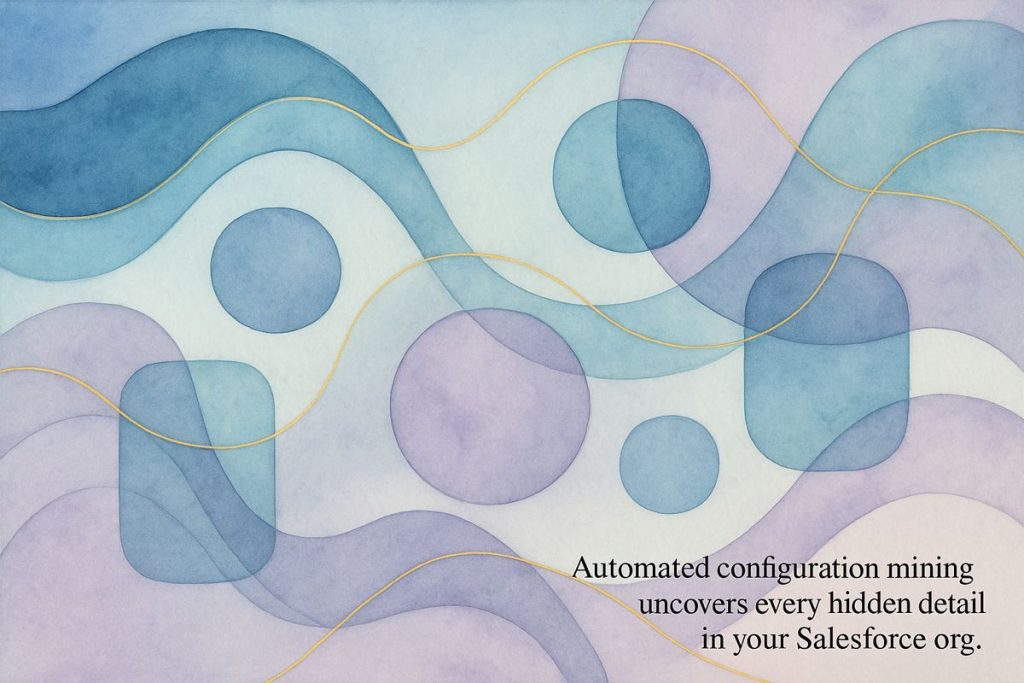Configuration mining for Salesforce is like turning on a bright light in a messy, forgotten attic. It uses smart tools to automatically find and document every object, field, rule, and workflow hiding in your system. This makes it much easier for companies to follow rules, pass audits, and not get lost in chaos. For teams in strict industries like pharma, this can feel like a huge relief—saving time, stress, and even making teamwork smoother. With complexity always creeping in, configuration mining is quickly becoming a must-have for Salesforce organizations.
What is configuration mining for Salesforce orgs and why is it important?
Configuration mining for Salesforce orgs is the automated process of analyzing metadata—objects, fields, custom code, and workflows—to create up-to-date documentation. This helps organizations manage complexity, ensure compliance, streamline audits, and quickly identify changes or risks within their Salesforce environment.
The Strange Art of Finding What You Forgot You Built
Let’s face it—Salesforce orgs don’t so much evolve as accrete, like stalactites growing in a forgotten cave. One day you’re demoing a new workflow for compliance, and the next, you’ve got 287 custom fields, half a dozen Apex triggers, and an ancient validation rule named after a project manager who left in 2018. Configuration mining, in its emerging weirdness, is the lantern that finally lets us see what’s lurking in the metadata palimpsest.
But what is configuration mining? (I had to stop and ask myself this the first time I heard the term; I thought it was a typo.) Unlike process mining, which reconstructs the dance of business ops from event logs, configuration mining peers straight into the technical guts. It sifts objects, fields, custom code, workflows—every quirk and twist that gives an org its shape. Think of elements.cloud or UiPath’s Salesforce Process Mining Guide—tools that unearth the details like an archaeologist brushing away centuries of dust. You can practically smell the ozone of freshly cracked open legacy—an oddly comforting tang.
Compliance, Chaos, and the Case of the Disappearing Documentation
If you’ve ever tried to prep for an audit in life sciences or pharma, you’ll understand the cold terror of realizing your org’s documentation is out of date, again. Regulations—like GxP—don’t care about your late-night deployment hack. Here’s where configuration mining earns its stripes: it automates the slog.
No more trawling through Setup, cursing under your breath as you try to remember why you created “Field_42_Temp” in the first place. Instead, configuration mining tools whip up living documentation straight from the metadata—mapping dependencies, spotting ad hoc changes, and flagging anything that might send your auditor’s eyebrows skyward. AI doesn’t sleep, and neither do automated change logs. That’s not hyperbole: I once had an audit land on my desk a week early (ugh). The only reason I survived? Automated documentation flagged a rogue workflow someone had created after too much coffee. Saved by the bot, not the bell.
Need specifics? These tools log every change—every single custom field, every process builder flow. There’s a hyperspectral quality to their analysis, slicing the org into its component wavelengths. Suddenly, troubleshooting and upgrades stop feeling like walking through a fogbank.
How Is This Not Process Mining? (And Why Both Matter)
You’d be forgiven for confusing configuration mining with process mining—they sound like twins separated at birth. The difference is subtle but crucial. Process mining peels apart event logs to reveal how business flows meander (or stall) across your Salesforce org. It’s Sherlock Holmes with a magnifying glass, reconstructing the scene of the inefficiency crime. See research.aimultiple.com and processmaker.com for the gory details.
Configuration mining, meanwhile, cares about the bones, not the footprints. It’s more like a forensic anthropologist reconstructing the skeleton of your org. For compliance-heavy industries, knowing how the system is configured matters as much as knowing how it was used. Both approaches are essential. I used to think one would outshine the other, but that was a rookie’s mistake. Now, I see it’s more like having both a map and a compass. Or two cups of coffee, if you prefer.
Life Sciences, Pharma, and the Cartographer’s Delight
If you work in a regulated industry, you know the feeling: a mix of dread and grim determination. Every undocumented change is a risk—a potential audit landmine. Enter configuration mining: suddenly, onboarding new admins is faster, technical debt shrinks, and team collaboration stops feeling like herding cats. Just last quarter, I helped a pharma client map their org’s 900+ customizations—Xavery Lisinski would’ve been proud.
Regulatory reporting? Faster. Audit prep? Less hair-pulling. Impact analysis? No more educated guesses. The emotional punch? Relief, bordering on giddy. Bam!
The field is catching on—consultancies and software vendors are racing to build smarter tools. And while the zeitgeist changes quickly, one thing’s constant: complexity creeps back, so you need to keep the lights on. I’d bet my next espresso that configuration mining will be table stakes for enterprise Salesforce teams by 2025.
A Few Good Links (and Some Coffee Stains)
If you’re itching to dig deeper, or just want to see what your peers are up to, start here:
- Configuration Mining: What Is It?
- Process Mining in Salesforce
- Process Mining vs. Task Mining vs. Process Discovery
- UiPath Salesforce Process Mining Guide
To sum up: configuration mining is not just another fleeting buzzword. It’s the technocratic lantern that reveals your org’s skeleton, warts and all. Sometimes, you need to see the ugly to fix it. And, well, sometimes you just need another cup of coffee…
